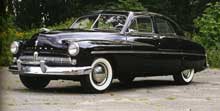I don’t expect Father Christmas or anyone else to bring me a new car this season, much as I would welcome it. But sixty years ago today something like that happened to my family, although it was the local dealer, not Santa, who delivered a new Mercury.
The 1949 Mercury was “All New” – though ours was one of the later models: the ’49s had been introduced in March 1948. Originally intended to be the 1949 Ford, it was the last design from the studio of E.T. Gregorie before he left Ford Motor Company., When the smaller Ford from the consultancy of George Walker was chosen, the “old Ford” was bumped upstairs to be a Mercury, and the putative Mercury became the entry-level Lincoln.
Just four body styles were offered, a two door Coupe that was more of a sedan and a handsome station wagon of half-timbered construction with a lovely woodgrain dashboard – friends of ours had one. At the top of the line was a convertible, but the most popular was our model, the four-door Sport Sedan. The 110 bhp engine was a larger, 255 cid version of Ford’s venerable flathead V8. Priced from $1,979 to $2,716, they were competing with Oldsmobile, DeSoto, Chrysler and even the Packard Eight.
For 1950, Mercury got a cosmetic facelift and a new dashboard. The 1951 cars were more heavily facelifted, and lengthened with longer rear fenders. A prestige model for 1950 and ’51 was the fabric-roofed Monterey, a stopgap measure to counter GM’s hardtops.
Our Sport Sedan was black, like this one, but lacking whitewalls and fender skirts. The interior and dashboard were almost opulent for the day – our car had green where this one is blue, but otherwise was the same.
It was logical for us to buy a car that winter – more than a year earlier we had replaced Mommycar, the 1935 Ford, with a Willys Jeep. Intended to be truck, tractor and passenger car, it proved more of the former than the latter. I had never understood, however, just how the transaction came about.
My mother kept a daily journal for nearly 50 years. I was recently reading the 1949 volume, and therein lay the answer. My uncle was being married on the 23rd of December that year. On the 22nd she wrote: “Frank Howe brought the Mercury over for us to borrow for the afternoon and took the Jeep back to work on.” Frank was the sales manager at the local garage; “the afternoon” presumably referred to the following day’s wedding. On Saturday the 24th, we learn “When Phil called Frank Howe to ask if we might keep the car over the weekend, he said ‘Well, you better keep it at least a year’.”
We kept it for nine years, until it was traded on the Peugeot 403. Oddly, we took few pictures of it, and most of those were during our “Polaroid period,” the products of which faded badly. Here it is outside our house, and here at my cousin’s in New Jersey.
Part of my puzzle was how we paid for two new vehicles in little more than a year. We were of modest means, but my father had an aversion to debt. The entry for Thursday, December 29, 1949, tells all: “We took out a note with the garage to pay for the car. It was so nice to be able to handle it all through Mr. Tracy [the bank manager] and Frank Howe. I still can’t believe that we can own such a beautiful bit of luxury. But we have waited a long time for such an indulgence. We are like snails, putting our house money on wheels and riding around in it.”

